Is the world of art embracing diversity?
A look inside MoMA’s collection reveals the changing landscape of artists and artworks.
The Museum of Modern Art (MoMA) is a pioneering institute that exhibits modern, contemporary artworks. Established in 1929 in New York, MoMA has grown to be the largest and the most influential museums of modern art with a growing collection of over 200,000 artworks by more than 25,000 artists.
MoMA has published its collection spanning the last 150 years of artists and artworks. This catalogue paints a rich picture of the idiosyncratic paths that have led diverse artists to exhibit at MoMA as well as the evolving tastes in art.
Art is intrinsically a human endeavour and it is valuable to contextualise the data in terms of the socio-cultural setting of the artist. This analysis takes a split-view by looking through the lens of data and the history of artists and attempts to bring them together into a cohesive narrative.

While a large chunk of artists (41%) are either American-born or immigrants to America, over 125 countries have an overall representation. The gender distribution is largely skewed towards males even in the developed nations. Interestingly, some of the smaller nations like Afghanistan and Kuwait have no male representation. The British artist Patrick Staff is the only catalogued non-binary artist.



The French have contributed over 22,000 artworks to MoMA making them the most productive nation of artists however, only about 400 of these artworks were created by women. A similar pattern exists for other major countries like Spain, Britain, Germany, and America. Among the smaller nations, Yugoslavia stands out despite having only about 3 women out of 19 artists and yet producing more artworks than their male counterparts.



Traditional media like printmaking, drawing and illustration have continued to flourish seeing a steady growth in practitioners between the 19th to 20th centuries. New media like video, installation, and audio have little to no representation in the 19th century but saw an upspring in the 20th century. Media like software which has taken deep roots in the artistic community has seen negligible representation or is labeled under more general categories like design. For instance, John Maeda’s seminal interactive works — The Reactive Square, Flying Letters, 12 o’clocks — are classified under design as opposed to software.




As MoMA’s collection has evolved and grown since its inception, the facets of art and artists captured by the catalogue has evolved as well. While this essay only captures a small subset of unique artistic journeys, it is encouraging to see an increasing emphasis on diversity of unique voices.
